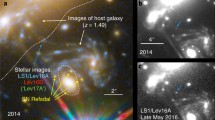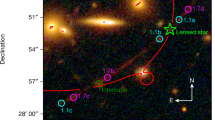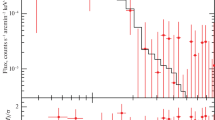Abstract
SRGe CL2305.2–2248 (SPT-CL J2305–2248, ACT-CL J2305.1–2248) is one of the most massive galaxy clusters at high redshifts (\(z\simeq 0.76\)) and is of great interest for cosmology. Deep images have been obtained at the Russian–Turkish 1.5-m telescope (RTT-150) for an optical identification of this cluster. In combination with the open Hubble Space Telescope archival data, they have made it possible to select candidates for gravitationally lensed images of distant blue galaxies in the form of arcs and arclets. The observed giant arc near the brightest cluster galaxies allows the Einstein radius to be estimated, \(9.8\pm 1.3\) arcsec. The photometric redshift of the lensed source has been found (\(z_{s}=2.44\pm 0.07\)). Its use in combination with the Einstein radius estimate has made it possible to independently estimate the mass of SRGe CL2305.2–2248 by extrapolating the strong-lensing results to large radii and using model density profiles in relaxed clusters. This extrapolation leads to mass estimates smaller than those obtained from X-ray and microwave observations by a factor of \({\sim}1.5{-}3\). A probable cause of this discrepancy may be the galaxy merger process, which is also confirmed by the morphology of SRGe CL2305.2–2248 in the optical range.





Similar content being viewed by others
Notes
The angular diameter distance is defined as the ratio of the object’s diameter in physical units to its angular size in radians.
REFERENCES
M. Bartelmann, Astron. Astrophys. 313, 697 (1996).
L. E. Bleem, S. Bocquet, B. Stalder, M. D. Gladders, P. A. R. Ade, S. W. Allen, et al., Astrophys. J. Suppl. Ser. 247, 25 (2020).
R. A. Burenin, I. F. Bikmaev, M. R. Gil’fanov, A. A. Grokhovskaya, S. N. Dodonov, M. V. Eselevich, I. A. Zaznobin, E. N. Irtuganov, N. S. Lyskova, P. S. Medvedev, A. V. Meshcheryakov, A. V. Moiseev, S. Yu. Sazonov, A. A. Starobinskii, R. A. Syunyaev, et al., Astron. Lett. 47, 443 (2021).
H. Dahle, N. Aghanim, L. Guennou, P. Hudelot, R. Kneissl, E. Pointecouteau, et al., Astron. Astrophys. 590, L4 (2016).
A. R. Duffy, J. Schaye, S. T. Kay, and C. Dalla Vecchia, Mon. Not. R. Astron. Soc. 390, L64 (2008).
J. Einasto, Tr. Astrofiz. Inst. Alma-Ata 5, 87 (1965).
O. Y. Gnedin, A. V. Kravtsov, A. A. Klypin, and D. Nagai, Astrophys. J. 616, 16 (2004).
M. A. Henson, D. J. Barnes, S. T. Kay, I. G. McCarthy, and J. Schaye, Mon. Not. R. Astron. Soc. 465, 3361 (2017).
M. Hilton, C. Sifón, S. Naess, M. Madhavacheril, M. Oguri, E. Rozo, et al., Astrophys. J. Suppl. Ser. 253, 3 (2021).
N. Lyskova, E. Churazov, and T. Naab, Mon. Not. R. Astron. Soc. 475, 2403 (2018).
J. Merten, M. Meneghetti, M. Postman, K. Umetsu, A. Zitrin, E. Medezinski, et al., Astrophys. J. 806, 4 (2015).
J. F. Navarro, C. S. Frenk, and S. D. M. White, Astrophys. J. 462, 563 (1996).
P. Predehl, R. Andritschke, V. Arefiev, V. Babushkin, O. Batanov, W. Becker, H. Becker, H. Boehringer, et al., Astron. Astrophys. 647, A1 (2021).
M. Shirasaki, E. T. Lau, and D. Nagai, Mon. Not. R. Astron. Soc. 477, 2804 (2018).
R. Sunyaev, V. Arefiev, V. Babushkin, V. Bogomolov, K. Borisov,M. Buntov, H. Brunner, R. Burenin, et al., Astron. Astrophys. 656, A132 (2021).
J. A. Smith, D. L. Tucker, S. Kent, M. W. Richmond, M. Fukugita, T. Ichikawa, et al., Astron. J. 123, 2121 (2002).
B. C. Whitmore, S. S. Allam, T. Budavari, S. Casertano, R. A. Downes, T. Donaldson, et al., Astron. J. 151, 134 (2016).
ACKNOWLEDGMENTS
This study is based on observations with the eROSITA telescope onboard the SRG observatory. The SRG observatory was built by Roskosmos in the interests of the Russian Academy of Sciences represented by the Space Research Institute (IKI) within the framework of the Russian Federal Space Program, with the participation of the Deutsches Zentrum für Luft- und Raumfahrt (DLR). The SRG/eROSITA X-ray telescope was built by a consortium of German institutes led by MPE, and supported by DLR. The SRG spacecraft was designed, built, launched and is operated by the Lavochkin Association and its subcontractors. The science data are downlinked via the Deep Space Network Antennae in Bear Lakes, Ussurijsk, and Baykonur, funded by Roskosmos. The eROSITA data used in this paper were processed with the eSASS software developed by the German eROSITA consortium and the proprietary data reduction and analysis software developed by the Russian eROSITA Consortium. We are grateful to TÜBITAK, the Space Research Institute, the Kazan Federal University, and the Academy of Sciences of Tatarstan for their partial support in using the Russian–Turkish 1.5-m telescope (RTT-150) in Antalya.
This study is based on observations made with the NASA/ESA Hubble Space Telescope and obtained from the Hubble Legacy Archive, which is a collaboration between the Space Telescope Science Institute (STScI/NASA), the Space Telescope European Coordinating Facility (ST-ECF/ESAC/ESA), and the Canadian Astronomy Data Centre (CADC/NRC/CSA).
Funding
I.F. Bikmaev, R.A. Burenin, and S.N. Dodonov were supported by the Russian Science Foundation (project no. 21-12-00210). A.A. Starobinsky was supported in part by the Ministry of Education and Science of the Russian Federation (project no. 0033-2019-0005).
Author information
Authors and Affiliations
Corresponding author
Additional information
Translated by V. Astakhov
APPENDIX
APPENDIX
The analytical expressions describing the positions of tangential arcs in a spherically symmetric gravitationally lensed system, in which the lens density profile is described by the Navarro–Frenk–White profile, are presented in Bartelmann (1996). The properties of axisymmetric gravitational lenses are determined by their surface density \(\kappa(x)=\Sigma(x)/\Sigma_{\textrm{cr}}\), where
\(x\) is the coordinate along the radius in units of \(R_{\textrm{s}}\), \(c\) is the speed of light, \(G\) is the gravitational constant, \(D_{\textrm{d}}\) and \(D_{\textrm{s}}\) are the angular diameter distances from the observer to the lens and the source, respectively, and \(D_{\textrm{ds}}\) is the angular diameter distance from the lens to the source. The mass within a circle of radius \(x\) is specified by the expression
In the case of spherically symmetric lenses, source images in the form of tangential arcs arise close to the tangential critical curve defined by the condition \(m(x)=x^{2}\). The dimensionless surface density
where \(\kappa_{\mathrm{s}}\equiv\rho_{\mathrm{s}}r_{\mathrm{s}}\Sigma_{\mathrm{cr}}^{-1}\), corresponds to the volume density \(\rho(r)\) defined by Eq. (2). The dimensionless mass \(m(x)\) is specified by the expression
where
Rights and permissions
About this article
Cite this article
Khamitov, I.M., Bikmaev, I.F., Lyskova, N.S. et al. Estimation of the Mass of the Very Massive Galaxy Cluster SRGe CL2305.2-2248 from Strong Lensing. Astron. Lett. 48, 1–8 (2022). https://doi.org/10.1134/S1063773722010042
Received:
Revised:
Accepted:
Published:
Issue Date:
DOI: https://doi.org/10.1134/S1063773722010042




